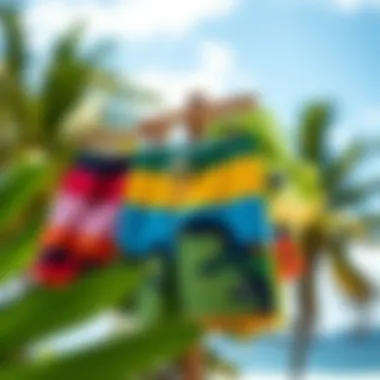Exploring Greenline Boardshorts: Design and Sustainability


Intro
As watersports gain momentum in contemporary culture, the demand for high-performance yet eco-friendly gear rises. When one thinks of exciting activities like surfing, paddleboarding, or beach volleyball, the choice of apparel plays a crucial role in both performance and comfort. Among the myriad options available, Greenline boardshorts stand out for their commitment to sustainability without compromising style or functionality. These shorts cater to a diverse audience ranging from seasoned athletes to casual beach-goers, blending practicality with aesthetic appeal.
In this article, we will explore the unique attributes of Greenline boardshorts, touching upon their materials, design elements, and overall importance in aquatic settings. Additionally, we'll dive into how these garments complement the latest trends seen in watersport activities, providing essential insights that will help you navigate your choices with confidence. With an emphasis on both utility and environmental considerations, our guide serves as a valuable resource for anyone looking to elevate their watersport experience.
Expert Insights
Latest Trends in Watersports
The world of watersports is ever-evolving, showcasing new techniques and styles that enhance both performance and enjoyment. Greenline boardshorts align perfectly with these trends, reflecting a shift towards sustainable practices within the watersport community. The rise of eco-conscious brands signifies a growing awareness; athletes now look for gear that harmonizes with their environmental values.
In recent years, fashion-forward designs have also influenced the materials used in boardshorts. Instead of traditional synthetic fabrics, brands like Greenline have started to incorporate recycled plastics, organic cotton, and other sustainable materials. This shift not only minimizes waste but also lends a fresh aesthetic appeal to the apparel.
Moreover, as more folks engage in various water activities, the demand for multi-functional and practical designs has surged. Features such as quick-drying capabilities, UV protection, and comfort-fit waistbands are becoming more commonplace, demonstrating that performance and sustainability can indeed go hand in hand.
Safety Protocols and Best Practices
When it comes to enjoying watersports, safety cannot be overlooked. Choosing the right apparel, like Greenline boardshorts, is just the start. Here are some key practices to ensure a safer experience:
- Understand the Environment: Familiarize yourself with the allure and potential hazards of your chosen watersport locale. Tides, currents, and weather must all shape your outing.
- Wear Suitable Gear: Invest in quality boardshorts that fit well and allow for full mobility. Long straps and excess fabric can become a snag hazard, while proper fitting reduces drag in the water.
- Layer Up: Depending on the water temperature, consider layering with a rash guard or wetsuit for added warmth and protection against UV rays.
- Stay Hydrated: It’s easy to forget about hydration while having fun. Drinking plenty of water before, during, and after your activity can help prevent fatigue and heat exhaustion.
"In the realm of watersports, knowledge is as vital as the gear you wear. Stay informed and safe while embracing your aquatic adventures!"
Utilizing these safety protocols ensures every outing is enjoyable and minimizes risks connected to the various watersports enthusiasts engage in.
As we navigate further into the unique attributes and designs of Greenline boardshorts, we'll explore their exceptional materials, fashion trends, and essential characteristics that make them a staple for water lovers around the globe.
Prolusion to Greenline Boardshorts
The introduction of Greenline boardshorts marks a significant step towards transforming the landscape of watersports apparel. These shorts are not just a piece of clothing; they represent a shift in mindset toward sustainability and functionality. For athletes, coaches, and recreationists alike, understanding the nuances of Greenline boardshorts is essential. This section delves into the innovative concepts behind these garments and their evolution over time, emphasizing their significance in today’s eco-aware market.
The Concept of Greenline
Greenline boardshorts encapsulate the essence of environmentally conscious fashion. They stand as pioneers in using recycled and sustainable materials in their production. This concept appeals to a growing demographic of water enthusiasts who are increasingly prioritizing eco-friendly options. What sets these boardshorts apart is not merely the fabrics used but the intention behind their creation.
Many consumers today are seeking apparel that aligns with their values. The movement towards Greenline apparel reflects a broader trend in the market where sustainability and performance coalesce. Water lovers want to enjoy their pursuits, like surfing or paddleboarding, without leaving a hefty environmental footprint. This has triggered brands to shift their production processes, ensuring that their practices benefit not just the individual but also the planet. The fact that these shorts often feature eye-catching designs reinforces their appeal, striking a balance between style and conscience.
The Evolution of Boardshorts
The journey of boardshorts traces back to the surf culture of the 1960s, where they were primarily designed for functionality rather than fashion. Initially, boardshorts were made from cotton and offered little in the way of quick-drying capabilities or water resistance. However, as watersports gained popularity, so did the demands for enhanced performance features. The transition to materials like polyester and nylon opened the door to boardshorts that dry faster, stretch better, and endure more rigorous conditions.
Greenline boardshorts take this evolution a step further. Manufacturers recognized that the advancements in materials shouldn't come at the expense of the planet. The integration of recycled materials into boardshort construction has paved the way for a new era. Brands have begun leveraging innovations that not only improve durability but also mitigate environmental degradation. This evolution in concept signifies a pivotal shift in understanding that performance can exist alongside environmental stewardship.
As boardshorts continue to adapt and evolve, the Greenline approach embodies the future of watersports apparel, showcasing that consumers no longer have to compromise between quality and sustainability.
"Sustainable products are not just a trend; they are the future, reflecting a deeper connection between consumers and the environment."
With this backdrop, it becomes essential to explore various aspects of Greenline boardshorts to truly understand their value. From the materials used, the unique design features, to the functional benefits, this guide will illuminate the elements that position Greenline boardshorts as a necessity for any watery adventure.
Materials Used in Greenline Boardshorts
The choice of materials in the production of Greenline boardshorts plays a pivotal role not only in their functionality but also in their environmental impact. With sustainability becoming a focal point in the garments industry, understanding the materials used in these boardshorts is essential for athletes, coaches, and recreationists alike, who are seeking to make tips and maximize the benefits of their gear.
Recycled Fabrics
Recycled fabrics stand at the forefront of eco-friendly materials used in Greenline boardshorts. By utilizing materials such as recycled polyester, manufacturers can significantly reduce the energy consumption associated with producing new fabrics. This practice not only helps in keeping plastic waste out of landfills but also decreases the demand for virgin materials.
For instance, companies often source plastic bottles to repurpose into woven fibers. One of the striking aspects of recycled fabrics is that they can be engineered to mirror the performance qualities of traditional materials. They can be just as resistant to water, wear, and tear. In fact, many athletes report that they feel no difference in performance when using gear made from recycled materials.
The appeal doesn't end with functionality. By wearing Greenline boardshorts crafted from recycled fabrics, wearers actively participate in a cycle of sustainability that bridges fashion and environmental consciousness. This transparency resonates loudly with consumers, indicating a tutorial transformation that reflects a growing concern for our oceans and waterways.
Biodegradable Components


Alongside recycled fabrics, biodegradable components form another critical part of the materials used in Greenline boardshorts. These components are designed to decompose naturally over time, reducing the waste that accumulates in landfills. While traditional boardshorts can linger in the environment for decades, biodegradable options promise a return to the earth, completing a much-needed life cycle.
One common example is the incorporation of specific types of plant-based fibers, such as organic cotton or even innovations like mushroom-based leather, which can break down effectively when exposed to elements. The introduction of these materials, though still evolving, displays a promising shift in how the textile industry views design and life expectancy.
"By focusing on biodegradable components, the aim is to break the cycle of waste that typical apparel often contributes to the environment."
Coupled with careful production processes that minimize chemical use, these components ensure that the overall carbon footprint of the boardshorts remains low. For watersport enthusiasts, this not only benefits them in their quest for performance but also aligns with a broader commitment to conserving the natural beauty of the oceans and beaches they cherish.
Design Features of Greenline Boardshorts
The design features of Greenline boardshorts play a pivotal role in enhancing not just style, but also functionality and performance in aquatic sports. In a time when aesthetics are often prioritized over sustainable practices, these boardshorts manage to strike a balance that appeals to environmentally conscious consumers and active water sports enthusiasts alike. The key elements of their design reflect a blend of innovative engineering and a commitment to reducing ecological impact, making them an important focal point in this guide.
Cut and Fit
The cut and fit of Greenline boardshorts are not just about looks; they're about performance in the water. A tailored fit ensures that the shorts stay snug, preventing them from flowing excessively while paddling, surfing, or engaging in other vigorous activities. The cut often varies between brands and styles, but many options nowadays lean towards a mid-length design that is suitable for a wide range of body types. This adaptable cut provides the freedom of movement vital for maneuvers without compromising comfort.
Considerations such as flexibility and breathability come into play here. Many boardshorts incorporate a stretch fabric blend, designed to expand with the body’s movements, allowing athletes to perform without feeling constricted. The waistband also deserves a mention; most are equipped with either adjustable ties or elastic features, offering a customizable fit that accommodates individual preferences.
"The right fit can elevate your watersport experience, turning potential discomfort into fluidity and ease."
This design choice caters to serious athletes who require a high-performance garment during their pursuits while also appealing to leisure users who may favor comfort alongside style.
Pockets and Accessories
When it comes to pockets and accessories, functionality meets practicality in Greenline boardshorts. Traditional pockets can sometimes hinder performance; however, many brands have adapted designs to ensure easy storage without sacrificing sleek lines or causing drag. Often, you'll find pockets strategically placed where they can hold essentials — like keys or small tools — securely without adding bulk.
Some newer models even incorporate water-resistant zippers or flaps to keep contents dry. This is a significant factor for those who enjoy surfing or paddleboarding and need their items to remain unaffected by splashes or spray.
Accessories such as loops for attaching lanyards or small gear further elevate these boardshorts in terms of usability, making them more than just a piece of clothing. It becomes a versatile tool that supports various activities, from beach volleyball to fishing. The design sense here resonates particularly well with those who appreciate a hybrid approach to active wear, allowing them to seamlessly transition between different aquatic activities while keeping all necessary items within reach.
Functional Benefits for Water Sports
When it comes to engaging in water sports, the right gear can make all the difference. Greenline boardshorts offer a range of functional benefits tailored specifically for aquatic activities. From resistance against water to overall durability and comfort, understanding these features helps both novices and seasoned athletes appreciate why these shorts are essential.
Water Resistance
The primary trait of any boardshort is its ability to withstand water. Greenline boardshorts excel in this department. Constructed with specialized fabrics, they repel water effectively. This characteristic not only ensures that the shorts stay light but also enhances overall performance in the water.
Water resistance has a couple of notable perks:
- Less drag: When the boardshorts resist water absorption, they reduce the extra weight that often leads to drag during swimming or surfing.
- Quick recovery: Athletes can transition seamlessly from the water to land without feeling bogged down by soggy fabric.
"Staying nimble in the waves means having gear that flows with you, not against you."
Durability and Comfort
Durability is paramount when selecting boardshorts for any water activity. Greenline boardshorts are designed to withstand the rigors of activities like surfing, paddleboarding, and beach volleyball. Their construction employs advanced stitching techniques, ensuring the seams hold up against the strain.
Furthermore, comfort is a top priority. These shorts are often crafted to allow for a full range of motion, which is crucial during dynamic movements. Key comfort features include:
- Stretchable materials: Often made with elastane blends, they move with you rather than restrict you.
- Soft interior lining: This enhances the wearing experience, minimizing irritation, especially when wet.
Quick Drying Properties
Another great feature found in Greenline boardshorts is their quick-drying capability. Quick drying fabric allows wearers to transition from water sports to dry land without the discomfort of overly wet shorts.
The benefits of this property are:
- Enhanced comfort in between activities: Athletes can focus on their performance rather than dealing with damp clothing.
- Better overall hygiene: The rapid evaporation of moisture helps reduce the growth of bacteria, which can cause odors.
In short, the functional benefits of Greenline boardshorts position them as a top choice for anyone serious about engaging in water sports. By opting for these shorts, one isn't just making a fashion statement; they are investing in an enhanced experience on the water.
Sustainability in Watersports Apparel


Understanding sustainability in watersports apparel is crucial, especially in an age where environmental concerns are at the forefront of global discussions. As people are increasingly engaging in water-based activities, the garments we choose play a significant role in the health of our oceans. When we talk about sustainability, we encompass a wide range of issues, such as the environmental implications of textile production, the impact of plastic waste, and the ethical considerations surrounding labor practices.
Environmental Impact of Traditional Boardshorts
Traditional boardshorts are often made from materials like polyester and nylon, derived from petrochemicals. This manufacturing process not only consumes fossil fuels but also emits greenhouse gases. Did you know that the production of just one kilogram of polyester can release approximately 6.2 kilograms of CO2 into the atmosphere? Additionally, improper disposal of these synthetic fabrics contributes to the ever-growing problem of microplastics in our oceans.
- Toxic Chemicals: The dyeing and finishing processes for standard boardshorts frequently involve hazardous chemicals that can pollute local water sources.
- Waste Generation: The production process itself can lead to substantial waste, with leftover fabric and unsold inventory ending up in landfills, where they do not biodegrade.
- Resource Intensive: The cultivation and processing of natural fibers can also be detrimental to the environment, often requiring large amounts of water and affecting local ecosystems.
Validating these impacts necessitates a shift in our choices as consumers, paving the way for brands that prioritize environmental stewardship.
How Greenline Boardshorts Mitigate These Issues
Enter Greenline boardshorts, which aim to counteract many of the negative aspects of traditional boardshort production. These boardshorts are designed with a sustainable mindset that places environmental health at the forefront. Here’s how they tackle those pesky problems:
- Recycled Materials: By utilizing fabrics made from recycled plastics, Greenline boardshorts help reduce plastic waste in our oceans. For instance, one pair might contain fibers from several plastic bottles that would otherwise have ended up in a landfill or, worse, the sea.
- Biodegradable Components: Unlike conventional boardshorts, Greenline incorporates biodegradable materials. These materials break down safely unlike standard synthetics, significantly reducing the long-term impact on the environment.
- Local Manufacturing: Opting for local production cuts down on transportation emissions. Many brands are now forming partnerships with local artisans to create their products, thereby bolstering local economies in the process.
- Eco-Friendly Dyes: Instead of relying on harsh chemicals, Greenline boardshorts use natural dyes or less harmful alternatives, reducing the toxic load on waterways.
The emphasis on sustainable practices signifies a larger trend in the recreational apparel industry towards respecting the delicate balance of our ecosystems.
"Sustainability isn't just a word; it's a commitment to future generations. Choosing eco-friendly boardshorts can help protect our oceans for years to come."
As conscientious athletes, recreationists and coaches, we have the power to choose apparel that reflects our values while enhancing our sporting experience. When opting for gear, consider not only how it performs in the water but also its role in preserving that very water for the next generation.
Popularity Among Watersport Enthusiasts
The world of watersports is vibrant and fast-paced, and the gear we choose reflects our values and needs. Greenline boardshorts have gained traction in this space, not just because they perform under pressure, but also due to their environmental consciousness. In an age where climate awareness continues to rise, the popularity of these shorts speaks volumes about the evolving preferences among those who ride the waves.
The surge in demand for Greenline boardshorts can be attributed to several key factors:
- Eco-Consciousness: Athletes today are more aware of the environmental impact of their gear. Greenline boardshorts resonance comes from their commitment to sustainable materials, appealing to those who prioritize the planet alongside their passions.
- Performance and Functionality: Beyond their eco-friendly aspects, these shorts are designed for optimal performance. Enthusiasts appreciate technologies like quick-drying fabrics and durability that stand the test of saltwater and sun.
- Fashion Trends: The aesthetic appeal of boardshorts can't be discounted. Greenline has successfully blended style with function, making them a go-to choice for both the beach and casual outings post-surf.
Market Trends
As we look closer at the market trends, there's a noticeable shift in consumer habits that favor sustainability. Recent studies show that younger generations, particularly Millennials and Gen Z, are driving the demand for ethically produced apparel. They are often seen connecting their identity with their choices in gear, reflecting a broader shift in consumer consciousness.
In the realm of boardshorts, brands like Greenline are not just riding the wave; they are creating it. This movement can be traced back to:
- Increased Awareness: Social media platforms are a hotbed for discussions around climate change and sustainable fashion. With endorsements from athletes and influencers, Greenline boardshorts gain visibility and encourage consideration from potential buyers.
- Innovation in Product Development: Companies that focus on innovative materials or unique design features adapt quickly to consumer feedback. The successful launch of styles catering to varied tastes solidifies Greenline’s position in the market.
- Collaborative Efforts: Partnerships with environmental organizations and initiatives not only enhance brand image but also reinforce a commitment to sustainability, helping bring in more consumers who value corporate responsibility.
"Sustainability isn’t just a trend; it’s woven into the fabric of future sports gear customization and selection."
Consumer Preferences
Consumer preferences in the watersport sector show a marked tilt towards sustainable options. Buyers are now great research detectives, often diving deep into product materials, company missions, and even production processes before making a purchase. They lean towards brands that align neatly with their ethos.
- Desire for Transparency: Shoppers are curious about where the materials come from and how ethically they are sourced. Transparency about supply chains can build brand trust, and Greenline closely illustrates this with detailed information on sourcing and manufacturing.
- Functionality Meets Style: There’s an ever-increasing demand for multifunctional apparel. Boardshorts that seamlessly transition from surf to shore, boasting both comfort and trendy designs, are very much in favor. Greenline has carved a niche here, showing that sustainability doesn't need to compromise style.
- Community and Values: Consumers want to feel part of a larger movement. Boardsport enthusiasts are not merely buying into a product; they are engaging with a community that values environmental responsibility. Greenline’s active engagement in community building resonates with this desire, thus boosting their popularity even further.
As we can see, the narrative surrounding Greenline boardshorts is not just about the shorts themselves but about what they represent. Their rise is a testament to the inclinations of modern consumers who prioritize sustainable living while cherishing their love for water activities.
Comparison with Conventional Boardshorts
In the lively world of water sports, where gear can make or break the experience, understanding how Greenline boardshorts stack up against traditional ones is crucial. This comparison not only highlights the performance aspects but also addresses the significance of sustainability in choosing the right gear for aquatic adventures. With the increasing emphasis on environmentally friendly products, athletes and leisure enthusiasts alike are becoming more discerning about their choices.
Performance Metrics
When we talk about performance metrics, we’re diving into the heart of what makes boardshorts tick. Greenline boardshorts have taken cues from their conventional counterparts but made substantial improvements to stand out. Here’s a closer look at the key performance elements:
- Water Resistance: Most traditional boardshorts offer some level of water resistance. However, Greenline boardshorts often incorporate advanced hydrophobic treatments that ensure they repel water more effectively. This means less waterlogged shorts, greater freedom of movement, and a more comfortable ride.
- Breathability: A crucial factor that can influence an athlete's performance is breathability. Greenline boardshorts typically feature lightweight fabrics that allow for superior ventilation. This means that even on the hottest days, wearers benefit from airflow that helps regulate body temperature, keeping them cool while paddling or surfing.
- Flexibility: The freedom of movement is paramount in water sports. Conventional boardshort fabrics can occasionally be restrictive. In contrast, Greenline options often employ materials with added stretch or freedom of movement, allowing for greater agility during aquatic maneuvers. This flexibility can be the difference between a smooth ride and a wipeout.
"The difference in design and material not only impacts comfort but also can enhance performance in the water, letting you concentrate on what truly matters: the waves."
Cost Analysis
Now, let’s shift our perspective to another important facet – the cost. Traditionally, consumers might assume that environmentally friendly products come with a hefty price tag. This can be a deterrent for many when considering Greenline boardshorts, but let’s break it down.


Initial Investment vs. Longevity
While the upfront cost of Greenline boardshorts might be higher than conventional options, it's essential to consider the long-term value.
- Durability: Many Greenline products boast longer lifespans thanks to their high-quality materials. This means less frequent replacements, which can save users money over time.
- Environmental Cost: Choosing sustainable options also means investing in the environment. The manufacturing processes for Greenline boardshorts often have lower environmental footprints, reducing overall harm. Consumers today are weighing environmental costs against financial ones more seriously than ever.
- Wearing They Save You: When comparing similar styles and performance levels, it’s not uncommon to find that Greenline boardshorts, while more expensive initially, often hold up better after prolonged use. Less wear and tear translates indirectly into financial savings.
Care and Maintenance of Greenline Boardshorts
When it comes to boardshorts, especially eco-friendly varieties like Greenline, care and maintenance are crucial not only for their longevity but also for preserving their ecological integrity. Boardshorts are put through rigorous activities, often exposed to saltwater, sun, and sand. Proper care can significantly extend the life of these garments, ensuring athletes get the performance they need while also supporting sustainable practices.
Washing and Drying Recommendations
Caring for Greenline boardshorts starts with understanding the right ways to wash and dry them. While it might seem simple, the method you choose can drastically affect the fabric's quality and performance.
- Cold Wash: Use cold water to wash your boardshorts. Hot water can break down the fibers, leading to faster wear and tear. Always opt for a gentle cycle to prevent friction against other garments.
- Mild Detergent: Choose a mild, eco-friendly detergent that won't harm the delicate fibers of the shorts. Harsh chemicals can compromise the waterproof coatings that make these shorts functional in water.
- Avoid Fabric Softeners: While it may seem counterintuitive, fabric softeners can clog the pores in high-performance fabrics, reducing their breathability and moisture-wicking properties.
- Air Drying: Instead of tossing them in the dryer—which can shrink them—hang them up to air dry. Ensure they're in a shaded area away from direct sunlight to prevent fading. If you live in a humid climate, allow ample space between the garments to facilitate airflow.
By adhering to these recommendations, water sports enthusiasts can ensure their Greenline boardshorts remain as effective as the day they were bought.
Longevity Tips
To maximize the life of Greenline boardshorts, consider the following tips that go beyond washing and drying. These practices ensure that your investment in sustainable apparel pays off.
- Rinse After Use: After a day at the beach or out on the water, rinse your boardshorts with fresh water. This helps remove salt and chlorine residue that can degrade the fibers over time.
- Storage: When not in use, store boardshorts in a cool, dry place. Avoid folding them tightly, which can cause creases or weaken the fabric. Instead, roll them to preserve shape.
- Check for Damage Promptly: After each use, inspect your shorts for any signs of wear, like fraying seams or tears. Addressing minor issues early can prevent larger problems down the line.
- Rotate Usage: If you have multiple pairs of Greenline boardshorts, rotate your usage. Frequent wear of the same pair can lead to quicker deterioration.
By taking a little time to properly care for your Greenline boardshorts, you not only maintain their functionality but also contribute to a more sustainable world.
In summary, the care and maintenance of Greenline boardshorts are key components of owning a high-quality, eco-friendly product. By following the recommended washing techniques and employing sound longevity practices, you can ensure that your boardshorts endure the rigors of water sports while making a positive impact on the environment.
Future of Greenline Boardshorts
As we navigate through a world increasingly conscious of environmental issues, it's vital to understand where Greenline boardshorts are headed. The focus on sustainability doesn't just end with current production practices; it plays a pivotal role in shaping future innovations and market trends. Many watersport enthusiasts are keen on making choices that don’t just serve their interests but also resonate positively with the planet.
Innovations in Material Technology
The quest for greener materials is ever-evolving. Right now, Greenline boardshorts are largely made from recycled polyester and bio-based fabrics, but the future looks even brighter. New technologies are sprouting up, aiming to take sustainability a notch higher.
For instance, brands are exploring the feasibility of using algae-based fabrics. Algae is a renewable resource that grows rapidly and could significantly lower carbon footprints. Moreover, innovations such as self-cleaning properties in fabrics are on the horizon, potentially reducing the need for frequent washing, thereby conserving water and energy.
"Progress isn't binary; it's a journey full of innovative twists and turns that can lead us toward a more sustainable future."
This focus on sustainable innovations could offer advantages that reach beyond Earth-friendly benefits. Imagine boardshorts that adapt to your climate, keeping you cool in the sweltering sun or warm when temperatures dip unexpectedly. This kind of technology could further enhance performance metrics, appealing to both athletes and casual water lovers alike.
Potential Market Growth
The market for eco-friendly apparel is on the rise, and Greenline boardshorts are in a prime position to capitalize on this growing demand. Recent studies indicate that consumers are shifting their preferences towards brands that showcase sustainable practices. This trend is particularly true among younger generations who prioritize ethical brand values.
Forecasts predict that the global market for sustainable apparel could reach significant heights in the coming years. With sportswear, specifically, gaining traction, the opportunity for Greenline boardshorts to gain a foothold is substantial.
- Increased engagement with eco-awareness: Many water sports organizations are beginning to adopt environmentally-friendly practices, further aligning themselves with brands like Greenline.
- Emerging markets: Regions previously overlooked by traditional brands are starting to embrace sustainable options. Places with rich aquatic resources but less accessibility to conventional markets present fertile ground for expansion.
- Collaborative initiatives: Brands teaming up with local environmental groups can enhance credibility and visibility, driving interest and building a loyal customer base.
The bottom line is that the future of Greenline boardshorts aligns not only with performance and comfort but also with eco-consciousness, marking a refreshing shift in the world of watersports apparel. The potential growth in this market signals exciting times ahead, providing ample opportunities for innovation and outreach.
The End
The conclusion of this article brings the focus back to the essence of Greenline boardshorts in today's environmentally conscious world. It wraps up the discussion about their function and serves as a gentle nudge for consumers to consider the benefits of making eco-friendly choices in their gear. As we dive into each aspect of the Greenline boardshorts, it's clear that they are more than just swimwear; they represent a shift in how we approach fashion in relation to the environment.
Summarizing Key Points
Throughout this guide, several key points make the case for choosing Greenline boardshorts:
- Eco-Friendly Materials: Made from recycled and biodegradable fabrics, Greenline boardshorts reduce environmental harm.
- Design and Functionality: With features like enhanced water resistance and quick-drying properties, they cater directly to the needs of water sports enthusiasts.
- Sustainability Impact: By selecting these boardshorts, consumers take a stand against the environmental impact of traditional apparel, promoting a sustainable approach to leisure activities.
- Aesthetic Appeal: Stylish designs ensure that athletes don’t have to sacrifice fashion for functionality.
"Sustainable choices today lead to a healthier planet for tomorrow."
Choosing Greenline boardshorts not only improves your performance in the water but also contributes to a global movement toward a greener planet. Every small choice adds up, fostering a culture of respect towards nature in what we wear and use.
Encouragement for Sustainable Choices
As we look to the future, the shift toward sustainable watersport apparel, like Greenline boardshorts, is essential. It's important for athletes, recreationists, and coaches alike to embrace this movement. Making the switch isn't just about trading up your gear; it's about joining a community dedicated to preserving scenic beaches, crystal-clear waters, and vibrant ecosystems.
The choices we make with our purchases influence manufacturing practices. By opting for environmentally-friendly options, we send a clear message to brands that prioritize sustainability. As consumers, let's advocate for more transparency in material sourcing, production processes, and overall environmental impact.







